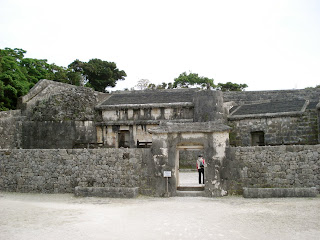This distant speck of a prefecture, historically and geographically closer to Taiwan and China than Japan, is a strange, sad, wonderful place. To many, Okinawa evokes images of pristine beaches, clear water, and a relaxed island culture that features reggae and hip hop music. This is one face of Okinawa.
Another face of Okinawa proper is, in the words of Robyn, my friend and host during my brief 5 day holiday there, the 'concrete eyesore' (to be fair, nearly all Japanese cities are concrete eyesores). At least Naha is, and everyone says Okinawa City is even more ghetto. But there is, at least in my eyes, a kind of alluring quality to the crumbling storefronts and faded facades. Okinawa has character.
The fact that Naha, Okinawa and other cities in Okinawa appear so old is an interesting paradox inasmuch as no building on the main island is older than 60 years. Over 80 percent of the island was bombed to rubble by the U.S. near the end of World War II and as such, practically every structure you see on Okinawa is relatively new; rebuilt during the post-war period. The crumbling oldness in Okinawa is, in fact, more to do with the fact that Okinawa is Japan's poorest prefecture than the passing of time.
Some very terrible things happened to Okinawa and her people during WWII in which many Okinawans were not only killed in battle, but also sometimes ordered by the Japanese military to commit mass suicides (to avoid capture by the barbarious Americans).
Okinawans are now often seen as a resilient, hardy people who nonetheless, or perhaps because of these hardships, also have a reputation for being much more laid back and carefree than the rest of Japan. Maybe they see more than others how fleeting life can be and thus, are determined not to let their office be their coffin, as is the case for too many mainland Japanese salarymen/women.
Another face of Okinawa proper is, in the words of Robyn, my friend and host during my brief 5 day holiday there, the 'concrete eyesore' (to be fair, nearly all Japanese cities are concrete eyesores). At least Naha is, and everyone says Okinawa City is even more ghetto. But there is, at least in my eyes, a kind of alluring quality to the crumbling storefronts and faded facades. Okinawa has character.
The fact that Naha, Okinawa and other cities in Okinawa appear so old is an interesting paradox inasmuch as no building on the main island is older than 60 years. Over 80 percent of the island was bombed to rubble by the U.S. near the end of World War II and as such, practically every structure you see on Okinawa is relatively new; rebuilt during the post-war period. The crumbling oldness in Okinawa is, in fact, more to do with the fact that Okinawa is Japan's poorest prefecture than the passing of time.
Some very terrible things happened to Okinawa and her people during WWII in which many Okinawans were not only killed in battle, but also sometimes ordered by the Japanese military to commit mass suicides (to avoid capture by the barbarious Americans).
Okinawans are now often seen as a resilient, hardy people who nonetheless, or perhaps because of these hardships, also have a reputation for being much more laid back and carefree than the rest of Japan. Maybe they see more than others how fleeting life can be and thus, are determined not to let their office be their coffin, as is the case for too many mainland Japanese salarymen/women.
Enough of the heavy.
________________________
My visit to Okinawa was really a visit to my friend Robyn, whom I had met at JET orientation in Toronto so many years ago. She basically devoted 3 whole days to me; driving around, showing me beaches, mountain-top restaurants, and all the places you don't get to see on tour.
Some photos:
 Robyn on the left, her friend and fellow Canadian Khadija at the tombs of ancient Ryukyuu royalty.
Robyn on the left, her friend and fellow Canadian Khadija at the tombs of ancient Ryukyuu royalty.

Shuri Castle. Tons of Chinese influences in the design.




Robyn approaching the best pizza place in Japan. Located on the top of a very green hill, you have to drive through windy tiny roads , weaving your way through vineyards and gardens until you come across this place (which was packed). Great view, great decor (all old dark wooden beams and boards) and great pizza. Two kinds: Meat, or Veggie.






















